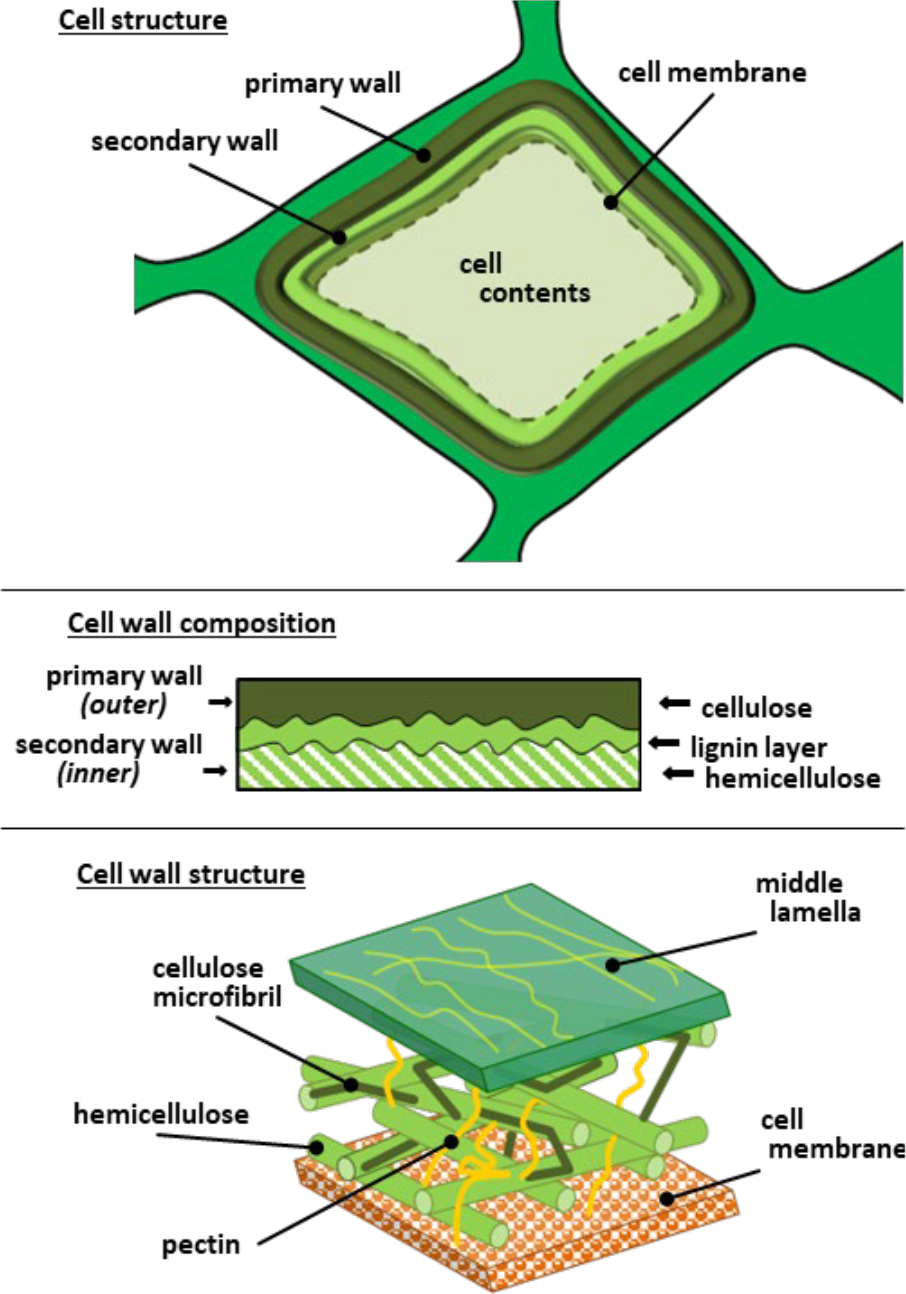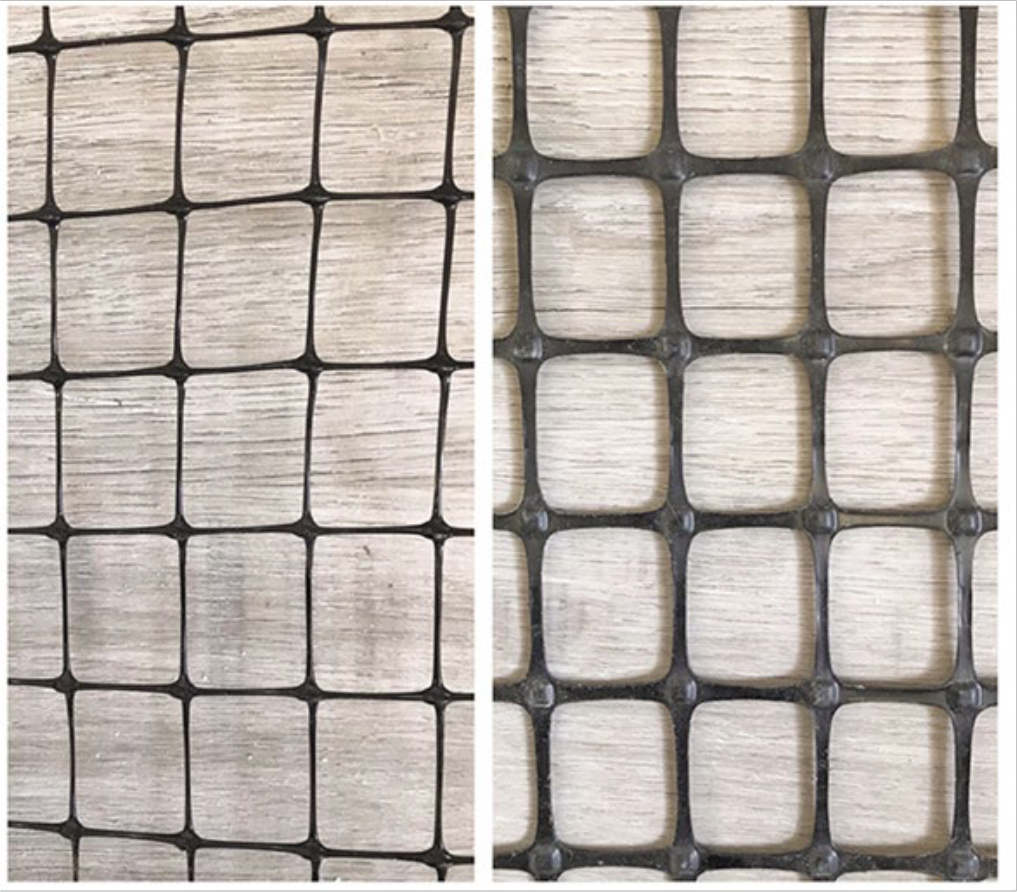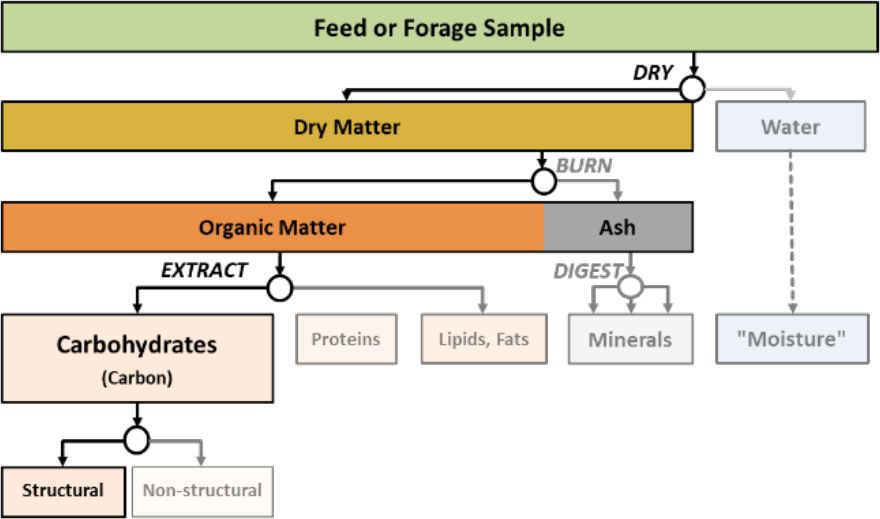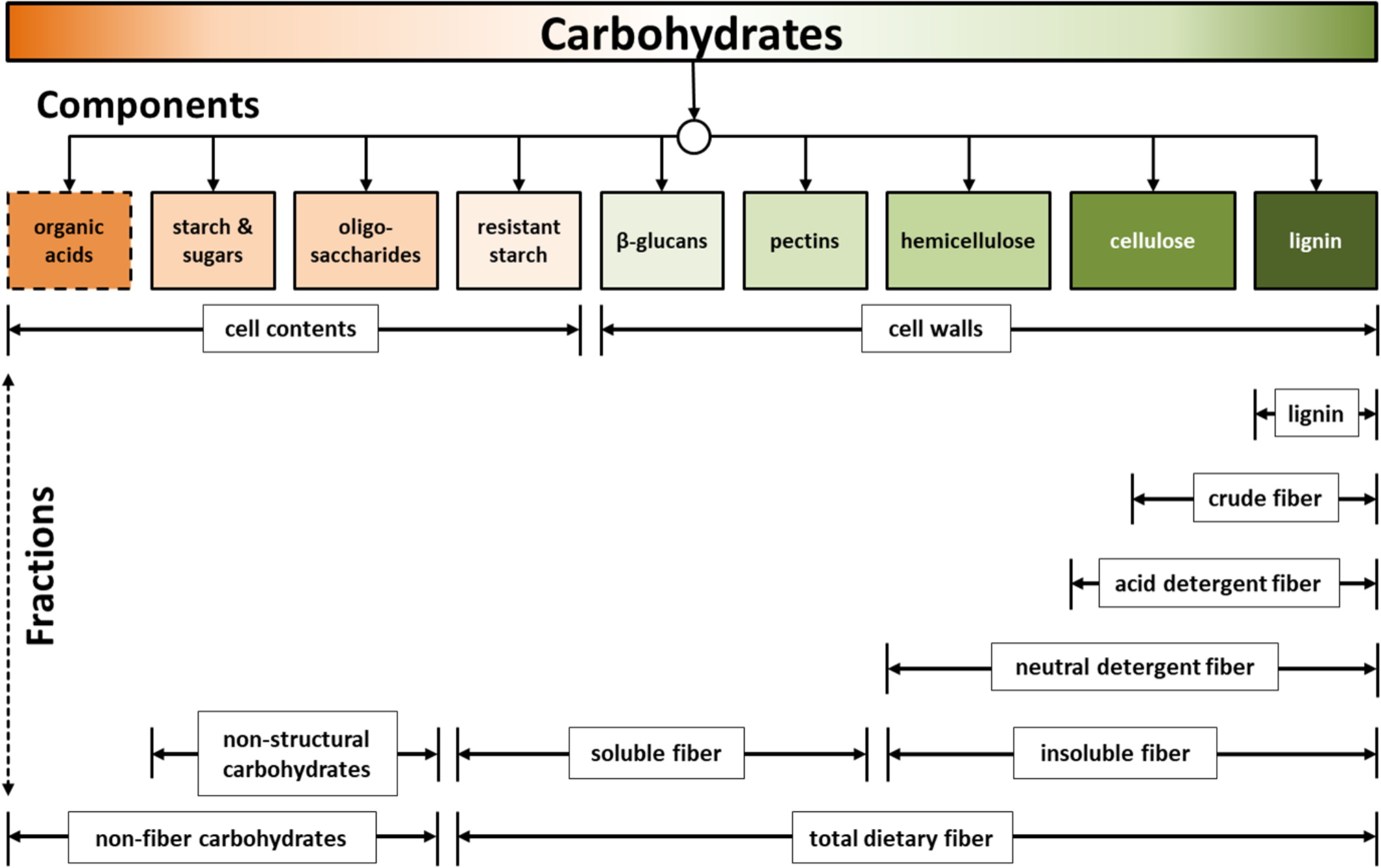⇦ Back to Livestock and Feedstuff Management Home
¶ Introduction
Carbohydrates are a class of biochemical compounds composed of the elements carbon, hydrogen and oxygen. They are the major components of plant cells and tissues and are the main source of energy for animals. Plant cell components can be divided into two simple fractions - cell contents and cell walls (see Figure 1).
¶ Figure 1. Structure and Composition of Plant Cells and Cell Walls

The cell contents or “cell solubles” consist mainly of sugars, starches, proteins, and minerals. The cell contents are typically classified as “non-structural” carbohydrates. They primarily store and supply energy for animal metabolism. All animal types can digest cell solubles, provided the cell walls are not intact and able to release the contents into the animal digestive system.
The cell wall components are classified as “structural” carbohydrates, providing structural support for the plant and enclose the cell contents.
“Fiber” can be defined as structural carbohydrates that are not readily digestible by enzyme activity, but are partially or completely digestible by rumen microorganisms. Fibers are less available for energy metabolism than are non-fiber carbohydrates.
Dietary fiber includes both insoluble compounds (cellulose, hemicellulose, lignin) and certain soluble compounds (fructans, pectans, galactans, and betaglucans). The fraction of dietary fiber that can be utilized for energy depends on the digestive system of the animal, whether monogastric (single-stomached) or ruminant.
¶ Importance of Fiber Content
Soluble dietary fibers can be utilized for energy by both monogastric animals (swine, horses, and poultry) and by ruminant livestock (cattle, goats, and sheep). Diets of ruminant livestock can include large amounts of forage with high content of the insoluble fibers that would be indigestible for monogastric livestock.
The amount and type of fiber from a forage source is important in developing livestock diets, especially ruminant rations. Grass-type forages usually have higher fiber content than legume forages. Grains and concentrates typically have a very low fiber content.
As forages mature, their fiber content increases and cell soluble content decreases, so have lower digestible nutrient contents than do younger forages. This is illustrated by the bird screens in Figure 2. The bird screen on the left represents the cell walls of an immature forage. The screen on the right represents the thickened cell walls of a more mature forage with a proportionately higher insoluble fiber content.
Fiber-digesting bacteria found in the rumen will digest a portion of the structural carbohydrates making up the cell The ration carbohydrate and fiber contents in ruminant diets must be managed properly to maximize and maintain forage intake, digestibility, and rumen pH. Starch digesters tend to tolerate low rumen pH levels, but the fiber digesters are inhibited by low pH.
¶ Figure 2. Bird Screens Used to Illustrate Cell Wall Differences for Immature Forage (Left) and Mature Forage (Right)

¶ Measuring Fiber Content
Fibrous structural carbohydrates are extracted from the dry matter portion of the feed sample (see Figure 3). The extracted materials contain organic matter and ash. Various analytical methods are used to identify and estimate different fiber fractions.
¶ Figure 3. Basic Work Flow of Carbohydrate Analysis

The most common methods used to estimate fiber content in feed ingredients and feeds include analysis for crude fiber, acid detergent fiber (ADF), and neutral detergent fiber (NDF). Other methods are used to estimate the soluble and insoluble fractions of total dietary fiber and of non-starch polysaccharides.
The ADF and NDF methods are widely used to quantify the insoluble fibers: cellulose, hemicellulose, and lignin. Cellulose and hemicellulose have variable digestibility, while lignin is nearly indigestible (see Table 1).
¶ Table 1. Fiber Fractions, Components, and Digestibility |
|||
| Fraction | Component | Digestibility | |
| CELL WALLS | NDF | Hemicellulose | 20% to 80% |
| Cellulose | 50% to 90% | ||
| Lignin | 0% to 20% | ||
| ADF-CP* | variable | ||
| Keratin | variable | ||
| Insoluble ash | 0% | ||
| ADF | Cellulose | 50% to 90% | |
| Lignin | 0% to 20% | ||
| ADF-CP* | variable | ||
| Insoluble ash | 0% | ||
| ADL | Lignin | 0% to 20% | |
| Insoluble ash | 0% | ||
|
CELL SOLUBLES Solubles ≈ 100% - NDF% |
Starches | 95% to 100% | |
| Fats, lipids | 95% to 100% | ||
| Soluble | 95% to 100% | ||
| NPN** | 95% to 100% | ||
| Sugars | 95% to 100% | ||
| Pectins | 95% to 100% | ||
| *ADF-crude protein or heat-damaged protein | **Non-protein nitrogen | ||
The two detergent fiber methods (ADF and NDF) provide an accurate estimate of insoluble dietary fiber, but do not identify soluble dietary fibers. These various fiber fractions and their relationship to the analytical methods are illustrated in Figure 4.
¶ Figure 4. Carbohydrate Fractions and Relationship to Feed Analysis Results

The detergent fiber analysis system to determine ADF and NDF was originally developed in the 1960’s. It is a wet chemistry method that has been modified and updated since then to improve fiber analysis.
ADF and NDF can also be determined with near-infrared spectroscopy (NIRS), which reads the infrared light reflected from a feed sample. NIRS readings are converted to analytical results by using calibration equations developed from wet chemistry analysis. Accurate NIRS results depend on a good calibration database and proper definition of the feed sample.
Fiber fractions can be further characterized with other methods, like in vitro analysis. These various analytical results are then used to predict the comparative digestibility and potential energy content of the particular feedstuff for a ruminant animal under a given set of conditions and production levels.
In brief, ADF content is generally related to digestibility, NDF content is generally related to feed intake. Other analyses help fine-tune these digestibility and intake estimates.
¶ Cellulose, Hemicellulose
Cellulose and hemicellulose are both polymer compounds, but differ in composition and structure. Hemicellulose fiber is more easily degraded or broken down than cellulose, so each of these fibers contribute differently to the ruminant diet.
Polymers are large macromolecules composed of many smaller and similar molecules linked together in a repeating chain-like or ring-like fashion.
The cellulose molecule is made up of 7,000 to 15,000 glucose units. It has a linear, crystalline-type structure with a high molecular weight.
The hemicellulose molecule contains shorter chains - 500 to 3,000 units – made up of five different sugars. It has a lower molecular weight and a more complex structure than cellulose, with many branches.
In the cell wall structure, pectins are compounds that bind cellulose strands and hemicelluloses together to form a network of cross-linked fibers (see Figure 1).
¶ Lignin
Lignin represents the highly indigestible portion of the fiber fraction. Most properly harvested hays and silages have about 5% to 8% lignin.
It is a cell wall component located between the outer and inner cell walls (see Figure 1). Lignin can be thought of as a glue stick that holds both walls together.
Forages with a higher lignin content have lower digestibility. As a plant matures, the lignin content increases, the cell walls thicken, and forage quality declines. The increased lignin and thicker cell walls act as a physical barrier to microbial enzymes, reducing the digestibility of the cell wall.
Lignin is determined by treating the residue remaining after acid detergent extraction with either sulfuric acid or potassium permanganate. The result is often reported as “acid detergent lignin (ADL)”.
The lignin content may be reported as a percent of the total dry matter or as a percent of the NDF.
¶ Crude Fiber
The crude fiber method was developed in the 1860’s and was designed to divide carbohydrates into digestible and indigestible fractions. Crude fiber is considered indigestible, so high crude fiber indicates low energy content. Crude fiber values are typically lower than either ADF or NDF values.
The crude fiber extract is part of the proximate analysis system. It was once used as a standard for indigestible, fibrous ration components, but is not a good indicator of ruminant digestibility.
Crude fiber is commonly used today as the legal measure of fiber in grains and finished feeds. It is determined by first boiling the sample in sulfuric acid, then boiling in sodium hydroxide. The remaining undissolved residue is rinsed with dilute sulfuric acid, deionized water, and ethanol, then is reduced to ash in a high temperature oven. Crude fiber is calculated by subtracting the ash from the insoluble residue.
Crude fiber accounts for most of the cellulose, only a portion of the hemicellulose and lignin, and no ash - so it underestimates true fiber. It typically overestimates the digestibility of high fiber roughages and underestimates the digestibility of low fiber roughages.
¶ Acid Detergent Fiber (ADF)
Acid detergent fiber is the fiber fraction containing cellulose, lignin, and insoluble ash (mainly silica) that is insoluble in acid detergent. ADF is composed of highly indigestible plant material, typically the lignified or otherwise undigestible portions of plant cell walls.
ADF is negatively correlated with digestibility. As ADF increases in the diet, digestibility decreases. ADF values are commonly related to the overall quality of the feedstuff. ADF content has been commonly used as a single factor to predict digestibility and energy content of forages and roughages.
The ADF method requires boiling the sample in an acid detergent solution (pH 2). Then, samples are filtered after boiling to remove the cell solubles, soluble fibers, and hemicellulose. The remaining residue is cell wall fiber, primarily cellulose and lignin. The weight of the filtered and dried residue is divided by the original sample weight to determine ADF content.
An ADF content of 35% to 45% is common for most roughages, hays, or silages. Aftermath roughages, like straw or stalks, typically have ADF contents of 45% to 55%. Whole and processed cereal grains usually have ADF contents of 3% to 6%. Hulled grains, like oats or buckwheat, contain about 14% to 16% ADF. The ADF contents of legume seeds and oilseed grains vary widely.
Digestible dry matter (DDM) is a simple, general estimate of the total feed digestibility and is calculated from the ADF content.
- DDM% = 88.9 - (0.799 x ADF%)
Various calculations have been developed that use ADF content to estimate energy values, such as percent total digestible nutrients (%TDN), net energy for lactation, and others.
¶ Neutral Detergent Fiber (NDF)
Neutral detergent fiber is the fraction that contains hemicellulose, cellulose, lignin, and insoluble ash. It is a measure of the structural components of the plant, specifically cell wall. The difference between NDF and ADF is a measure of hemicellulose content.
Feed intake is an important component of total feed value. NDF is used as a predictor of voluntary intake because it provides information on the bulk or fill of the feed. As NDF increases in the diet, dry matter intake decreases. The NDF analytical values are related to feed intake and how much space the feedstuff will occupy in the rumen.
NDF is a valuable forage analysis for balancing dairy rations and estimating milk production. It can be useful for beef rations that primarily rely on forages, but is not as well correlated to beef animal performance.
The cell wall content of the plant increases as harvest maturity increases, so NDF increases and affects dry matter intake. General agreement among nutritionists is that cattle will consume about 1.2% of the body weight as the NDF fraction of the forage. Dry matter intake as percent of the body weight (%DMI) can then be predicted by dividing 120 by the percent NDF on a dry matter basis.
- DMI% = 120 ÷ NDF%
Low NDF values are usually more desirable, but particle size and other factors influence fiber effectiveness. For example, beef or dairy cattle diets that lack adequate fiber can damage the rumen wall.
A high level of fiber in the diet does not always mean the fiber is effective. If the fiber is chopped or ground too short or too finely, it may not promote rumen health. Finely ground fiber passes through the digestive system rapidly and does not meet effective fiber needs of cattle.
NDF is measured by boiling and refluxing the sample in a neutral detergent (pH 7) solution. The solution removes the easily dissolved pectins and the cell contents (proteins, sugars, lipids). Amylase, an enzyme, may be added to remove starch.
Samples are filtered, rinsed, and dried to recover the NDF fraction. The filtered residue retains the shape and bulkiness of the original sample. The residue is weighed and the result divided by the original sample weight to determine NDF content.
Fiber values for NDF are higher than ADF values, which are both higher than crude fiber values. NDF values for roughages, like hays, or silages, typically range from 45% to 70%. Aftermath roughages, like straw or stalks, typically have NDF contents of 65% to 75%. Whole and processed cereal grains range from about 10% to 20% NDF. Legume seeds and oilseed grains vary widely in NDF content.
¶ NDF digestibility (NDFD)
Neutral detergent fiber digestibility (NDFD) helps to benchmark fiber digestibility and to compare forage feeding values. It may be reported as “digestible neutral detergent fiber (dNDF)” or “cell wall digestibility (CWD)”.
NDFD is determined using the standard wet chemistry analysis plus an additional in vitro analysis. The objective is to mimic rumen digestion. Samples are dried, ground and incubated in rumen fluid for 12, 24, 30, and/or 48 hours. Thirty hours is the most common measurement for forages fed to dairy cattle because that is the average time forage remains in a high-producing cow’s rumen.
The digested fraction of the forage is the difference between the initial NDF measurement and amount of NDF left in the sample after the in vitro analysis (dNDF).
- NDFD = (dNDF ÷ NDF) x 100
The results may be reported as “NDFD12” or “NDFD30” to indicate the analysis time in hours. The results are used in various computer models to estimate the relative digestibility of the feedstuff.
¶ aNDF
“aNDF” is a designation that the enzyme amylase and sodium sulfite were used during the extraction procedure. The original NDF method was modified to include amylase in order to improve starch removal from the sample.
The solution used in the original method did not remove all of the starch from certain feeds during the refluxing step, so the starch remained as part of the insoluble residue after filtering. This remaining starch may then be improperly identified as NDF and would overestimate the final NDF result.
¶ aNDFom
“aNDFom” is a designation that NDF has been determined on an organic matter basis or “ash-free”. Most forages have an ash content ranging from 8% to 12%. In some cases, forages may have picked up dirt or minerals during harvest or processing. This extra mineral matter will remain in the filtered residue after extraction. The result is to overestimate the NDF content.
Determining NDF on an organic matter basis requires an additional analytical step. The residue remaining after the initial extraction with the detergent solution is placed in a high temperature furnace. The heat treatment removes the organic fibrous materials, leaving the mineral matter behind as ash. This remaining ash is weighed and subtracted from the unheated NDF residue weight to determine the amount of organic NDF by difference.
The normal ash content may impact the non-ashed NDF analytical results differently for different feeds. For example, corn silage typically has an insoluble ash content of 5% or 6%, so tends to have fewer problems. Sorghum silages range from about 9% to 12% insoluble ash so have greater potential for overestimating NDF because of the greater ash content.
¶ uNDF
The undigested neutral detergent fiber is the portion of the sample that is not digested after a certain number of hours of in vitro digestion. It is reported as a percentage of the dry matter. It will include a number to represent the typical rumen retention times of either 24, 30, 120, or 240 hours (e.g., uNDF30, uNDF240).
¶ Pectins
Pectins are a class of soluble fibers found in many plants such as wheat, oats and barley. Pectina is a major plant cell wall component, making up about 35% of the cell wall in dicotyledonous plants, 2% to 10% in grasses, and about 5% in wood. They may be the most complex macromolecule in nature, composed of as many as 17 different monosaccharides (simple sugars) and containing more than 20 different linkages.
Pectins are removed by the detergent solutions, so are not included in the ADF or NDF measurement. They help determine rigidity of plant tissue and control of the cell wall permeability for enzymes.
¶ Beta-glucans
Beta-glucans (or β-glucans) are a group of water-soluble dietary fibers found in the cell walls and consisting of a series of glucose units. They are obtained from oats, barley, yeast, and algae.
These compounds are used commercially to improve livestock growth and performance by helping to stimulate the immune system.
Beta-glucans are removed by the detergent solutions, so are not included in the ADF or NDF measurement
¶ References
Krueger, P. 2015. The language of nutrition: NDFd (Neutral detergent fiber digestibility). Progressive Dairy, 06 May 2015. accessed 27Jul2022 https://www.progressivedairy.com/topics/feednutrition/the-language-of-nutrition-ndfd-neutral-detergent-fiberdigestibility
AAFCO. 2017. Critical Factors in Determining Fiber in Feeds and Forages (report). Fiber Best Practices Working Group, Amer. Assn. of Feed Control Officials. January 2017. 14 pg.
Voragen, A.G.J., Coenen, GJ., Verhoef, R.P. et al. Pectin, a versatile polysaccharide present in plant cell walls. Struct Chem 20, 263 (2009). https://doi.org/10.1007/s11224-009-9442-z
Cumberland Valley Analytical Svc. Tech Notes. Why Use NDF Determined on an Organic Matter Basis (aNDFom)? 2 pg. https://www.foragelab.com/Media/Tech%20Note%20-%20NDFom%202%200.pdf
Van Soest, P.J. 1963. Use of Detergents in the Analysis of Fibrous Feeds II. A Rapid Method for the Determination of Fiber and Lignin. Journal of A.O.A.C. 46:830.
Mahanna, B., ed. Pioneer Silage Zone Manual. Corteva AgriScience. pp. 155-160.